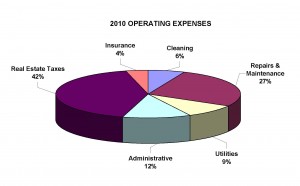By: Eileen Lewis, PICOR
TREND Report
September 2011
Building operating costs are a major component of the monthly rent paid by office occupiers each month, and property managers, landlords and tenants in Tucson’s office buildings are motivated to control expenses wherever possible. Expenses to maintain and operate buildings from the smallest garden office to multi-story high rise fluctuate annually based on many factors. Many costs to operate can be controlled, but other expenses such as real estate taxes, insurance rates, and components of utilities tend to increase based on market, municipal and rating agency actions, outside the control of building owners and managers.
Operating expenses are defined as all costs necessary to operate and maintain a property. In leased office buildings, the expenses charged to the tenants vary based on the lease language. Under certain lease structures, tenants may be concerned with expenses attributable to the ‘common areas’ of a building, while on a full service or gross basis, their lease may address expenses related to all occupied and common space. The major categories of operating expenses include real estate taxes, insurance, utilities, management, and repairs and maintenance.
Impact on property value
Not only do increases in operating costs impact the businesses who occupy the space, but building expenses directly impact property values. When applying a capitalization (cap) rate to a property income stream, every expense has a direct effect. For instance, at a 10% cap rate, each $100 increase in operating expense would reduce building value by $1,000.
Building owners rely on high occupancy to cover the costs to operate a building. Providing a high quality work environment with cost-effective building services gives that landlord a competitive advantage. Owners and property managers with larger portfolios can also leverage buying power to reduce costs through bulk purchasing and contracting initiatives, passing those savings through to businesses in their property. Lower operating costs often allow an investor to offer their space at a lower lease rate, and a track record of controlling building costs is attractive to tenants in choosing space.
Tucson operating cost trends
In properties under PICOR’s management, we track year-to-year changes in operating costs. At the end of the last full year of building performance, Tucson office building operating expenses decreased 2% over the previous year. Average operating expenses for office properties totaled $8.00 per square foot (psf) in 2010 versus an average of $8.16 psf a year earlier.

Expenses are broken down by category – Insurance, Real EstateTaxes, Cleaning, Repairs & Maintenance and Administrative. All categories portfolio-wide experienced a decrease, including real estate taxes and insurance. The Cleaning category experienced the largest decrease (26%) over 2009 primarily due to leveraging buying power and renegotiating contracts. The following chart provides a breakdown of where the dollars are being spent in building costs.
Strategies to control costs
There are multiple strategies for controlling operating costs – both for what is considered controllable and “uncontrollable” costs. At 45% of total building expenses, real estate taxes represent a large slice of the pie. Appealing property tax values can be very effective in ensuring real estate taxes are competitive and appropriate. An appeal can be performed with or without expert help, though there are firms and individuals with this core competency, many of whom charge a percentage of tax savings.
Lighting and air-conditioning are the major utility hogs in Tucson office buildings. Taking advantage of retrofitting opportunities and rebate programs can be very helpful in not only reducing repair and maintenance costs, but can bring down ongoing utility consumption. While the “green building” initiatives are not as extensively used in the Tucson area as in larger markets, being aware and taking advantages of opportunities as they arise will aid in keeping costs down. Many strategies are available to reduce water consumption, as well.
Insurance represents another opportunity. Reviewing and rebidding coverage can result in savings. Many very good insurance agents specialize in commercial real estate, some of whom represent multiple carriers and markets. While there can be overlap with the companies they approach, some insurance companies have exclusive relationships. Expert advice from a qualified insurance agent can save a substantial amount of money and can ensure that coverage and deductibles are appropriate. Bundling several properties together in a package policy can be an effective strategy if multiple properties are owned. On the other hand, being a smart consumer and shopping the coverage periodically can allow an owner to take advantage of potentially lower rates.
Professional property management is a key strategy in being able to keep operating expenses under control. A management company can leverage their buying power, and if they’re large enough, be able to pass along substantial savings to their clients. As an example, we contracted for waste removal services for a portfolio of 45 buildings and achieved an overall 20%+ savings. While there is value in relationships and consistent service providers, this must be weighed with periodic rebidding of services to ensure pricing is in line with the current market. A property manager provides access to quality vendors who provide superior service. Staying abreast of current trends and taking advantage of new products is an important part of expense control.
Arizona’s projected return to full economic health is expected to be several years away. In the near term, we will continue to experience pressure to minimize costs. Employing sound expense control strategies, maintaining strong provider relationships and creative problem-solving will be keys to staying ahead of the competition and will provide office building occupiers an efficient and well maintained work environment.
This article originally appeared in the September 2011 TREND Report.
Eileen M. Lewis, RPA FMA leads PICOR’s property management division and is one of 13 principals. A long-time Tucsonan and 25 year veteran of the commercial real estate industry, Eileen has managed a portfolio of industrial, retail, and office buildings for private and institutional investors and served as Receiver for distressed assets. An active industry leader locally and nationally, she has served the Building Owners and Managers Association (BOMA), Commercial Real Estate Women (CREW) and others.
division and is one of 13 principals. A long-time Tucsonan and 25 year veteran of the commercial real estate industry, Eileen has managed a portfolio of industrial, retail, and office buildings for private and institutional investors and served as Receiver for distressed assets. An active industry leader locally and nationally, she has served the Building Owners and Managers Association (BOMA), Commercial Real Estate Women (CREW) and others.




